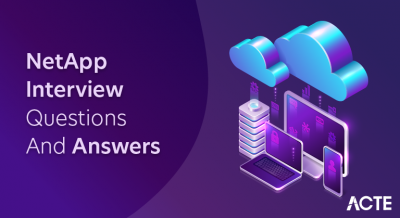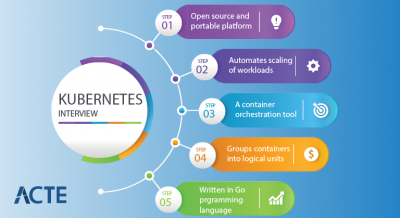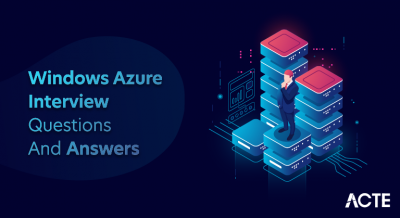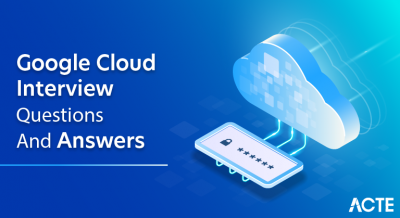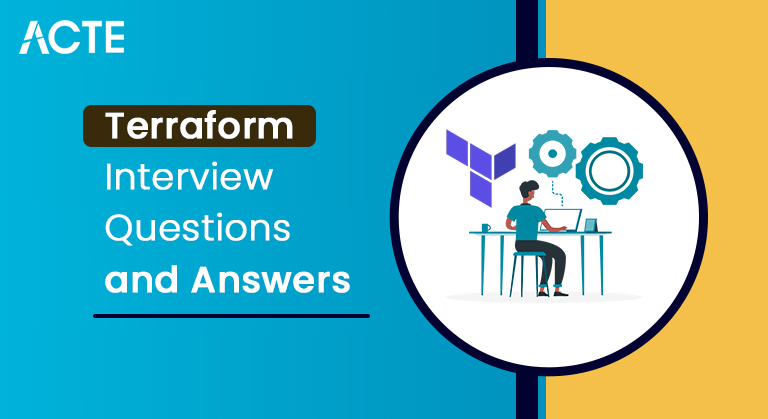
Terraform Professionals and expert trainers from ACTE systems are providing you with the important questions and answers that might be asked when you face an Terraform Interview. These questions and answers will help you in the preparation of the interview. Questions are relevant to Terraform and its applications. The following list includes the best important Terraform questions for freshers as well as Terraform questions and answers for experienced candidates to help them prepare for the interview. This complete guide of Terraform interview questions will encourage you to crack your Job interview easily.
1. What is terraform?
Ans:
Terraform is an open-source system software tool for communication that HashiCorp developed. It is a tool for creating, modifying, and versioning transportation safely and effectively. Terraform is able to oversee both conventional in-house solutions and currently recognized service providers.
2. Why is it tough to employ Terraform?
Ans:
Terraform is a tool for effectively and safely building infrastructure. Leading and well-known service providers, as well as unique internal solutions, can be managed with Terraform. The Terraform Configuration file lists the components required to execute a single application or your whole data center. After that, Terraform creates an execution plan that outlines the steps it will take to get to the desired state and carries it out to construct the specified infrastructure. It generates incremental plans of execution that can be implemented in response to changes in configuration.
3. Why was Terraform selected for DevOps operations?
Ans:
The following justifies Terraform’s selection for DevOps:
- Unlike Ansible and Puppet, it is capable of full orchestration as well as configuration management.
- Offers outstanding support for practically all well-known cloud service providers, including AWS, Azure, GCP, DigitalOcean, and others.
- Easily maintains an immutable (dynamic) infrastructure’s configuration.
- Offer unchangeable architecture that allows for seamless configuration updates.
- Easily transportable from one supplier to another.
4. What does “terraform it” mean to you?
Ans:
Terraform uses the command terraform init to initialise the code. The working directory for Terraform configuration files is configured with this command. Uses for the init command include: Terraform configuration files are initialized in a working directory by using the terraform init command. After creating a new Terraform configuration or cloning an existing one from version control, this is the first command that needs to be executed.
5. Who are a few of Terraform’s primary competitors?
Ans:
There are several Terraform alternatives. The following is a list of 10 IT automation software solution alternatives to Terraform, including Ansible, Attune, Kubernetes, Jenkins, Chef, Puppet, BMC Control M, SaltStack, Vagrant, and Pulumi.
6. Who is the provider for Terraform?
Ans:
A technology called Terraform is used to manage and inform various infrastructure resources, including virtual machines (VMs), network switches, real machines, containers, and more. Careful API transactions that disclose resources are the provider’s responsibility. Many cloud providers are compatible with Terraform. In Terraform, a provider is a plugin that makes it possible to communicate with an API. This covers software-as-a-service and cloud providers.
7.How is Terraform operated?
Ans:
Terraform develops an implementation strategy, outlines the steps it will take to reach the target state, and then carries it out to construct the infrastructure mentioned. When the configuration changes, Terraform can identify what changed and produce workable incremental execution plans. Terraform facilitates infrastructure automation.
8. What characteristics does Terraform have?
Ans:
Among these are the following:
- resource
- graphs,
- change automation,
- execution plans, and
- infrastructure as code.
9. What does the term “IaC” mean?
Ans:
“Infrastructure as Code” is abbreviated as “IaC.” IaC is a concept that allows developers to operate and provision computer data centers mechanically without having to engage in any physical processes. One of the IAC’s case tools is Terraform IAS. Infrastructure is represented via Infrastructure as Code (IaC).
10. How does the Terraform core operate?
Ans:
The Terraform core analyses and produces configuration-based analysis and assessment while looking at configuration monitoring. It monitors and contrasts the most recent and earlier versions before presenting the findings on the terminal. In order to interact with Terraform Plugins, Terraform Core leverages remote procedure calls (RPC) and provides a number of methods for finding and loading plugins.
11. What are Terraform’s salient characteristics?
Ans:
The main characteristics of Terraform are as follows:
- Infrastructure as Code: Your infrastructure is defined in declarative configuration files that are understandable by humans using Terraform’s high-level configuration language.
- A reusable, shareable, and editable blueprint can now be made.
- Before Terraform builds, upgrades, or destroys infrastructure, you can evaluate the changes.
12. What applications does Terraform have?
Ans:
The use cases for Terraform are as follows:
- Configuring an App on Heroku
- One well-liked platform as a service (PaaS) for hosting web apps is Heroku. After developing an app, developers add more features like a database or email service.
- Terraform may be used to automate the configuration of a Heroku application, guaranteeing the presence of all required add-ons. Still, it can also automate other configuration tasks, such as setting up Cloudflare or DNSimple to set a CNAME for the app.
13. Explain Software Demonstrations.
Ans:
Software is being more dispersed and networked in today’s environment. While tools like Vagrant can be used to create virtualized demo environments, showing software in real life is still challenging, as is building an infrastructure that nearly resembles production conditions.
14. How does Terraform assist with plugin discovery?
Ans:
With the authority “Terraform init,” Terraform reads configuration files from the operating directory. Terraform can occasionally download more plugins. In order to make sure that Terraform uses the same plugin versions, it then chooses the versions of the plugins to use and generates a security device file. In order to relieve developers of the burden of managing plugin discovery and RPC communication, Terraform Core offers a high-level framework.
15. How do you use Terraform Enterprise’s open-source or paid version?
Ans:
The open-source description of Terraform Enterprise does not allow for the addition of Terraform Policies. The greatest version of Terraform Enterprise could only communicate with the watch policies—the coding tool for open-source infrastructure. OpenTofu, formerly known as OpenTF, is a branch of Terraform, a community-driven, open-source project run by the Linux Foundation.
16. Define Terraform Modules .
Ans:
n Terraform, a module is a container for several concurrently used resources. The root module is needed for any Terraform that uses resources that are referenced in. tf files. A group of common configuration files stored in a special directory is called a Terraform module. Terraform modules reduce the amount of code you need to write for similar infrastructure components by encapsulating groupings of resources devoted to a single purpose.
17. Which Terraform commands are the most helpful?
Ans:
- Terraform init: Set up your working directory so that other commands can be executed.
- Terraform layout: Show the adjustments that the present configuration requires.
- Use Terraform: Establish or modernise infrastructure
- Terraform destroy: Destroy infrastructure that has already been built.
18. What Are The Resource Schedulers?
Ans:
Large-scale infrastructures make it more and more difficult to assign tasks to computers. A few schedulers that can assist with this difficulty are Kubernetes, YARN, Mesos, and Borg. These can be used to dynamically schedule Hadoop, Spark, Docker containers, and many other software applications.
19. What does “Terraform cloud” signify to you?
Ans:
Teams can utilize Terraform cooperatively with the help of an application called Terraform Cloud. A private registry for exchanging Terraform modules, comprehensive policy controls for managing the contents of Terraform setups, simple access to shared state and secret data, and more. Teams can use Terraform to provision infrastructure with the aid of Terraform Cloud, an application. One tool that makes using Terraform easier for teams is Terraform Cloud.
20. How does Terraform define a null resource?
Ans:
The main use of the null resource is as a container for random actions that do nothing—carried out by a provider. A null resource is an empty resource that can be used to specify provisioner blocks but doesn’t create anything on its own. Additionally, they include an attribute called “trigger” that, if it is triggered, can be used to regenerate the resource and, in turn, execute the provisioner block.
21. Is it possible to use Terraform for on-premise infrastructure?
Ans:
Infrastructure on-site can be constructed with Terraform. There are lots of different suppliers. Whichever option best meets your needs can be chosen. All you need is an API to develop client Terraform providers, which is something that many people do for themselves. In addition to supporting public clouds like AWS, Azure, and GCP, Terraform is also known for being cloud-agnostic and can be used with on-premise infrastructure like VMware vSphere and OpenStack.
22. What is the purpose of this command?
Ans:
- Terraform -version – to verify the Terraform version that is installe Terraform FMT is a tool for rewriting configuration files in the official formats and styles.
- Terraform providers: this provides a list of providers that are operational with the present configuration. Users are able to search the list using the which command. Generates the complete path of the command given as an argument out of the paths in the $PATH environment variable.
23. Enumerate all the Terraform versions that are supported: Bitbucket Cloud and Server.
Ans:
Azure DevOps Server and Services;
- GitHub.com;
- GitLab.com;
- GitHub Enterprise;
- GitLab CE and
- EE
24. Describe the meaning of the Terraform validate command in relation to Terraform.
Ans:
Terraform validates a directory’s configuration files, focusing just on the configuration and ignoring external services like provider APIs, remote state, and so on. Regardless of variables or current state, validate inspects a configuration to make sure it is internally consistent and syntactically proper condition.
25. What is locking state files?
Ans:
Terraform uses a feature called state file locking to stop several users from working on the same state file at the same time. This helps to stop corruption in state files. One example of a backend operation is obtaining a lock on a state file. An output, including a status message, will be displayed to you if obtaining a lock on the state file takes longer than anticipated.
26. What is Terraform in Remote Backend?
Ans:
In addition to operating in Terraform Cloud, the Terraform remote backend is utilized to store Terraform’s state. The remote backend provides access to numerous Terraform operations, including init, plan, apply, destroy (terraform version >= v0.11.12., get, output, providers, state (sub-commands: list, mv, pull, push, rm, show., shame, untainted, validate, and many more.
27. What Describes a Polluted Source?
Ans:
The resources that need to be recreated and destroyed after the next command are known as tainted resources. When you designate a resource as tainted, the state file is updated (delete and create., but nothing happens on the infrastructure. When a resource has terraformed taint, it indicates that it is damaged or deteriorated and will be regenerated during the subsequent apply action.
28. What Terraform on Azure callback functionality is available?
Ans:
Terraform performs Azure callbacks via Azure Event Hub. It helps to accomplish features like calling back to the system and other actions. Terraform AzureRM already has this feature to streamline the process. Callbacks on Azure are likely to occur while utilizing the Azure Event Hubs. The Azure provider for Terraform offers customers simple functionality.
29. How to Avoid Using the Same Resource Error?
Ans:
Depending on the circumstance and the requirement, there are three possible approaches.
- The resource will no longer be managed by Terraform code after it is deleted.
- By taking API resources out of service
- Bringing in action will also help with the removal of resources.
30. Describe the Terraform request flow’s architecture.
Ans:
Common Language Interface, or CLI (command package., is the command line interface. When a user begins the terraform application, execution instantly moves into one of the “command” implementations of the command package (not depicted in the diagram., with the exception of some early bootstrapping in the root package. The mapping between command package kinds and user-facing command names is stored in the commands. The root directory of the repository contains the go file.
31. How Can callbacks be made using Terraform?
Ans:
The type in Azure Execution is referred to. A vertex needs to be correctly completed before the graph walk may start assessing other vertices with “happens after” edges. The graph walk is stopped, and the errors are given back to the user if one or more mistakes are found during the evaluation.
32. What Is The Terraform Directory?
Ans:
In addition to managing cached provider plugins and modules, Terraform uses the Terraform Directory to keep track of the workspace that is presently in use and the most recent backend configuration in case the state needs to be moved during a subsequent run. Terraform directory, which Terraform utilizes to store the workspace that is presently in use, maintain cached provider plugins and modules, and store the last known backend configuration in case it needs to migrate state during the next run.
33. How does Terraform apply to disregard duplicate resource errors?
Ans:
The following options are worth a try:
- Use Terraform to reconstruct those resources after deleting them from the cloud provider’s API.
- Remove those resources from the Terraform code to end its administration.
- Import the resource using Terraform, then delete the code that tries to replicate them.
34. What is a Private Module Registry?
Ans:
Within an organization, Terraform Cloud users can create and privately share infrastructure modules by using the private module registry. You can exchange modules within or between organizations using Terraform Enterprise’s private module registry.
35. Is it possible to install several providers using Terraform?
Ans:
No, Because Terraform is not dependent on any one infrastructure or cloud provider, it is an extremely useful tool in multi-provider deployments. The same set of configuration files can be used to control all resources, exchange variables, and specify dependencies between providers. You can handle cross-cloud dependencies and manage various providers using the same workflow when you read Terraform. Large-scale, multi-cloud infrastructure management and orchestration become easier as a result.
36. In Terraform, what are Provisioners?
Ans:
Provisioners are used to run scripts on a local or remote system in order to create or destroy resources. Provisioners can be used for configuration management, cleaning before destruction, and resource bootstrapping, among other things.
37. Which are some of the provisioners that Terraform comes pre-installed with?
Ans:
Among the pre-installed provisioners in Terraform are:
The elements in question are abspath, dirname, path expand, basename, file, fileexists, fileset, and filebase64.
38. Describe a few noteworthy Terraform uses for us.
Ans:
Terraform can manipulate resources to a greater extent, but its applications are rather varied. Developing software demos, scheduling resources, deploying multiple clouds, creating disposable environments, developing multi-tier applications, setting up self-service clusters, and setting up Heroku apps are a few examples of the unique uses.
39. What elements make up the architecture of Terraform?
Ans:
The following characteristics of the Terraform architecture are present:
Sub-graphs; Evaluation of Expression; Vertex; Graph Walk; Graph Builder; State Manager; Configuration Loader; Command Line Interface (CLI.; Backend
40. Which Terraform commands are the most helpful?
Ans:
The following Terraform commands are helpful:
- fmt
- initialize
- validate
- Plan
- apply
- destroy
- Output
- Show
- state and
- version.
41. Define the resource graph In Terraform.
Ans:
The available resources are shown graphically in a resource graph. It permits the simultaneous production and alteration of separate resources. To build plans and refresh the state, Terraform models the graph’s configuration. It builds a system that is both efficient and effective in assisting us in comprehending the drawbacks.
42. How Can I Keep Private Information in Terraform?
Ans:
Terraform needs credentials in order to interact with your cloud service provider’s API. But these login credentials are often stored on your PC in plaintext. GitHub is exposed to hundreds of cryptographic keys and API keys every day. As a result, your API keys should never be explicitly saved in Terraform code. Use encrypted storage to store passwords, SSH keys, TLS certificates, and any other data that shouldn’t be kept in plain text.
43. Define the resource graph using Terraform.
Ans:
The resources are shown visually in a resource graph. It assists in simultaneously creating and modifying separate resources. Terraform creates a plan for the graph’s configuration in order to produce plans and update the state. It gives structure most effectively and efficiently possible so that we may comprehend the disadvantages.
43. How are you going to update the Terraform plugins?
Ans:
Since Terraform v0.10, Terraform providers are released independently of the Terraform binary. This makes it possible for them to update at various rates and for more individuals to work together on the providers. Although it creates an additional step for upgrading providers, this is mainly a good thing.
44. Describe the core Terraform workflow.
Ans:
Three steps make up the fundamental workflow of Terraform:
- Write: Produce code that serves as infrastructure.
- Plan: Make advance plans to see how the changes will appear before they are put into effect. ## Implement – Establish a dependable system.
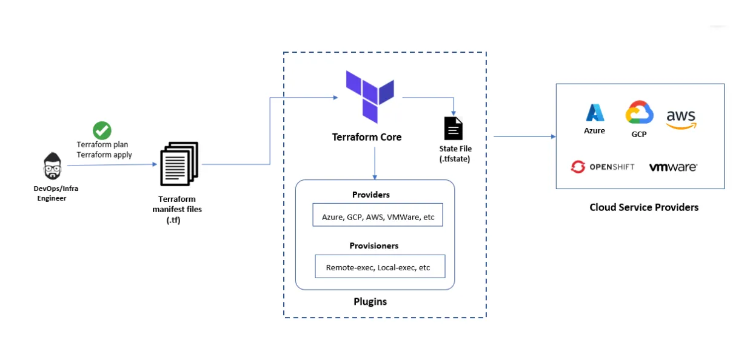
45. In the event that something goes wrong, how will you manage and regulate rollbacks?
Ans:
The prior iteration of the code will be recommitted to my VCS as the updated version. The old code will be executed by a terraform run that will be initiated. Terraform is more declarative, so keep that in mind. Verify that all of the information given in the rollback code is present in the old code.
46. How does Terraform define dependencies?
Ans:
To clearly state the dependency, use depends_on. The depends-on parameter allows you to provide additional resources as well, and Terraform will generate the target resource once all of the others have been produced.
47. In Terraform, what is the external data block?
Ans:
By making random data available for usage elsewhere, the external data source enables an external application to function as a data source. in the Terraform setup through the use of a particular protocol, which is described below.
48. How does Terraform apply to disregard duplicate resource errors?
Ans:
- Take those resources out of your Terraform code to stop handling them.
- Take out the resources from the cloud provider (API. and use Terraform to reconstruct them.
- Make use of those resources marketplace, both of which are critical to a major organization’s ability to support a producers-and-consumers content model and get rid of the Terraform code that’s trying to make them happen again.
49. What occurs when several engineers begin utilizing the same state file to deploy infrastructure?
Ans:
One important element of Terraform is called “state locking.” By guaranteeing that no modifications are made to the state file while it is being run, this feature keeps the state file from getting corrupted. It’s vital to remember that not all Terraform Backends support the state-locking capability. If this functionality is necessary, choose the proper backend.
50. What is the most verbose logging provided by the TF_LOG variable?
Ans:
If TF_LOG is not set to a log-level name, the default setting—which is the most lengthy—is TRACE. If logging is enabled, TF_LOG_PATH can be configured. To have the log always end up appended to a particular file.
51. What command can be used to make the Terraform state and the real-world infrastructure compatible with each other?
Ans:
Drift may be detected and managed with the use of terraform. Details on the actual condition of Terraform-managed infrastructure are kept in the state file. By comparing what Terraform thinks is running and its settings with what is actually running and configured, the program Terraform refreshes this state file.
52. How can I see a preview of the Terraform execution plan using this command?
Ans:
- Checks to see if the Terraform state is current by reading the current state of any existing remote objects;
- Compares the current configuration to the prior state and records any differences.
- Offers a series of modification actions that, if carried out, ought to bring the distant objects into compliance with the configuration.
53. What advantage does Terraform State offer? What are the advantages of utilizing Terraform modules?
Ans:
Bindings between remote system objects and resource instances that you provide in your setup are the main uses of the Terraform state. In reaction to a configuration change, Terraform creates a remote object, stores its identification to a particular resource instance, and can update or remove the item in the event that configuration changes in the future.
54. How Can I Keep Private Information in Terraform?
Ans:
Credentials are needed for Terraform to interact with the cloud provider’s API. However, these login credentials are typically stored on your desktop in cleartext. Every day, hundreds of API and cryptographic keys are exposed to GitHub. Therefore, you should never directly save your API keys in Terraform code. All of your passwords, SSH keys, TLS certificates, and other information that shouldn’t be kept in plain text should be kept on encrypted storage.
55.Which Terraform Azure Provider factors are some of the most recent ones?
Ans:
New data resources like Azurem_batch_certificate, which aids in certificate management, are included in the most recent versions. In networking, this resource is used to regulate the prefix. Bugs have been fixed, and azurerm_app_service has also been improved.
56. What Is Terraform Core:? Tell us about some of its main duties.
Ans:
Terraform users have an entry point provided by the built binary. The main duties consist of:
- Infrastructure reading and interpreting modules and configuration files as code functions.
- Building resource graphs;
- utilising RPC for plugin communication; • carrying out plans; • maintaining resource state
57. What is Terragrunt, and how does one use it?
Ans:
Terragrunt is a lightweight wrapper that offers additional capabilities for managing remote states, maintaining DRY setups, and interacting with numerous Terraform modules. It is employed for: • Managing several AWS accounts
- Keeping our CLI flags dry and executing Terraform commands on many modules
- Maintaining the DRY setup of our remote state and the DRY code of Terraform
58. Describe the term “tainted resource.”
Ans:
The following command must be provided in order to remove and regenerate a contaminated resource. When a resource is found to be contaminated, the state files are updated but otherwise remain unchanged. According to the terraform plan, support will be demolished and replaced. The changes take effect upon the subsequent application.
59. Define the Resource Graph in Terraform.
Ans:
The resources are shown on a resource graph. It lets you create and modify different resources at the same time. In order to update the configuration of the graph, Terraform develops a plan. It sets up a framework for us to swiftly identify disadvantages.
60. What levels of sentinel policing are there?
Ans:
- Notice: Although you have been logged in, you are free to go. Advice is sent when a user starts a plan against the rules.
- Soft Mandatory: Absent a specified override, the policy has to be approved. Administrators are the only ones with access to overrides.
- Hard Mandatory: Regardless of the situation, the policy must be approved. It is not possible to override this policy unless it is ended. This is the standard enforcement level in Terraform.
61. What are Terraform’s key components?
Ans:
Create your infrastructures as needed and manage them all as code with Terraform. The key components are:
- A console with the ability to convert HCL code to JSON format so that users may observe functions in action.
- An interpolation language is used to facilitate it.
- A module count tracks the number of modules placed on the infrastructure.
62. Explain IAC?
Ans:
Infrastructure as Code (IAC. makes it possible to build, modify, and manage infrastructure using code rather than human processes. Within an organization constructed in accordance with infrastructure standards, the configuration files may be changed and securely transferred.
63. What is the DevOps use case for Terraform?
Ans:
Terraform (HCL. uses the HashiCorp Configuration Language, which is similar to JSON. DevOps teams can easily design and enforce infrastructure settings across different clouds and on-premises data centers with the help of HCL, which offers a brief vocabulary.
64. Describe a Terraform cloud.
Ans:
The Terraform cloud is the platform that enables teams to work together on Terraform projects as needed or in response to particular situations. It is closely linked to the data and procedures of Terraform. A private registry manages the sharing of Terraform modules.
65. Define a great detail on Oracle Cloud Infrastructure.
Ans:
Oracle Cloud is a cloud computing service that is provided by a global network of data centers operated by Oracle Corporation. It consists of storage, servers, applications, services, and networks. You can use the Internet at any moment to access these services.
66. What is the “terraform backend,” and which version of GitHub is supported?
Ans:
Any Terraform setup allows for the specification of a backend, which defines two important things:
Systems that, in addition to GitHub, Terraform supports:
- GitLab CE; GitLab EE;
67. What is the function of a Private Module Registry?
Ans:
Distributing Terraform modules throughout your organization is made possible by Terraform Cloud’s Private Module Registry feature. You can establish guidelines or “sentinel policies” on the registry that control how your company’s employees use the modules. Import resources using Terraform, then remove any code that tries to duplicate them.
68. How can I see a preview of the Terraform execution plan using this command?
Ans:
- Checks to see if the Terraform state is current by reading the current state of any existing remote objects;
- Compares the current configuration to the prior state and records any differences.
- Offers a series of modification actions that, if carried out, ought to bring the distant objects into compliance with the configuration.
68. How many tiers exist inside the Sentinel enforcement hierarchy?
Ans:
Three enforcement levels are available for Sentinel: soft, hard, and advisory.
- Warning: You are logged in, but you are free to leave. Advice is sent out when a user starts a plan that is against the rules.
- Soft Mandatory: The policy has to be adhered to unless an override is mentioned. Administrators are the only ones with access to overrides.
- Hard Mandatory: In spite of everything, the policy has to be followed. This policy cannot be overridden until it is abolished. This is the default enforcement level for Terraform.
69. Distinguish between cloud formation and terraform.
Ans:
| Aspect | AWS CloudFormation | Terraform | |
| Provider Support | Primarily designed for AWS services. | Multi-cloud support, can manage resources across providers like AWS, Azure, Google Cloud, etc. | |
| Language | JSON or YAML templates | HashiCorp Configuration Language (HCL) | |
| State Management | Uses CloudFormation Stack to track and manage resources. | Uses Terraform State to store and manage resource information. | |
| Resource Types | AWS-specific resource types. | A broad range of resource types for various cloud providers and services. | |
| Modularit | Supports nested stacks for modularity. | Supports modularization using modules and reusable components. |
70. Which Terraform commands are the most helpful?
Ans:
- Terraform init: Set up your working directory so that other commands can be executed.
- Terraform layout: Show the adjustments that the present configuration requires. Use Terraform: Establish or modernise infrastructure .
- Terraform destroy: Destroy infrastructure that has already been built.
71. How can a duplicate resource error be disregarded while using Terraform?
Ans:
Use Terraform to reconstruct the resources after deleting them from the cloud provider’s API. You can remove certain resources from the code to prevent Terraform from managing them. Execute Enumerate every version control option available in Terraform. Supported version controls include the following ones: Bitbucket Server; Cloud Bitbucket; Azure DevOps Services; Gitlab Enterprise Edition (EE. and Enterprise Edition (CE.; Gitlab.comGitHub Enterprise, GitHub.com, and GitHub.com (OAuth.
72. How to Create the Resource Graph in Terraform.
Ans:
The resources are shown on a resource graph. It lets you create and modify different resources at the same time. In order to update the configuration of the graph, Terraform generates a plan. It sets up a framework for us to swiftly identify disadvantages.
73. How is IAC defined?
Ans:
Instead of using manual procedures, IAS as INFRASTRUCTURE AS CODE enables you to develop, modify, and maintain your infrastructure through coding. The configuration files can be securely disseminated around an organization and edited in accordance with your infrastructure criteria.
74. Which Terraform commands are the most helpful?
Ans:
Here are a few of the most practical Terraform commands:
Terraform output allows you to inspect Terraform outputs. Terraform refresh updates the state file. Terraform init initializes the current directory. Applying the Terraform code and creating objects is known as “terraform apply.” Terraform destroys – demolishes the structures constructed by Terraform.
75. Is it possible to use Terraform on Azure for callbacks?
Ans:
Callbacks on Azure are likely to occur while utilizing the Azure Event Hubs. The Azure provider for Terraform offers customers simple functionality. A Terraform instance already installed is offered via Microsoft Azure cloud Shell.
76. What are Terraform D and Init?
Ans:
An operational index containing Terraform pattern files can be initialized using the Terraform init control. It is possible to loop this control more than once. Run this command as soon as you’ve finished drafting the new Terraform design.
Terraform D: The majority of Windows and in-service systems use the Terraform D plugin.
77. What is the DevOps use case for Terraform?
Ans:
Terraform employs the HashiCorp Configuration Language (HCL., which is a configuration language similar to JSON. The DevOps team can easily design and enforce infrastructure configurations across different clouds and on-premises data centers because of the relatively simple syntax of HCL.
78. Which Terraform commands are the most helpful?
Ans:
Terraform init, which sets the current directory; Terraform refresh, which updates the state file; Terraform output, which displays outputs from Terraform; Terraform apply, which applies the Terraform code and builds things; Terraform destroy, which destroys what Terraform has built; Terraform graph, which creates a graph in DOT format; and Terraform plan, which is a test run to see what Terraform will do.
79. How is it possible to use Terraform on Azure for callbacks?
Ans:
Callbacks on Azure are likely to occur while utilizing the Azure Event Hubs. The Azure provider for Terraform offers customers simple functionality. A Terraform instance that has already been installed is offered via Microsoft Azure cloud Shell.
80. Define a Private Module Registry: What Is It?
Ans:
One feature of Terraform Cloud that lets you share Terraform modules with other people in the organization is the Private Module Registry. Regulations or “sentinel policies” can be enforced on the register that outlines the modules’ permitted uses for members of your organization.
81. What are some of the most recent Azure Provider factors for Terraform?
Ans:
Azurem_batch_certificate, a tool for handling certificates, and additional data resources are included in the most recent versions. In networking, this resource is used to regulate the prefix. Bugs have been fixed, and azurerm_app_service has also been improved.
82. What does the term “terraform backend” mean?
Ans:
Every Terraform setup has the option to define a backend, which identifies two key components:
• The location of operations and the state storage (Terraform maintains a state file that contains a list of all the resources created).
83. What applications does Terraform have?
Ans:
It ensures quick and consistent deployment without the need for a web interface. Additionally, Terraform facilitates the implementation of self-service infrastructure, allowing product teams to manage their services within organizational parameters. It is instrumental in monitoring, scaling, and rapidly creating environments, especially for staging and quality assurance, by codifying and sharing configurations.
84. How will an object from one module be made available at a high level for the other module?
Ans:
- The resource configuration defines the ab output variable.
- State module_A’s output variable.
- Make a variable.tf file for the module. B.
- Create the input variable in this file with the same name as the key specified in module_B. 5. Repeat the procedure to allow additional modules to access the variable.
85. Define the Terraform setup needed to launch a single Amazon EC2 instance.
Ans:
The Terraform setup needed to launch a single EC2 instance on Amazon is as follows:
Supplier “aws” resource “aws_instance”
“example” { region = “”} Name = “example”} tags {ami = “” instance_type = “” names
86. List every version control that Terraform supports.
Ans:
The following version controls are supported: Bitbucket Cloud; Bitbucket Server; Bitbucket Services;
- GitLab EE
- CE
- GitHub Enterprise
- GitHub.com
- GitHub.com (OAuth.,)
- GitHub.com.
87. What are the distinguishing characteristics of Terraform? module?
Ans:
With Terraform, you can build infrastructure as needed and manage it all as code. These are its salient characteristics:
A console that lets people see how things work . A configuration language with interpolation support; The ability to convert HCL code into JSON format; A module count that maintains track of the total number of modules deployed to the infrastructure.
88. What levels of sentinel policing are there?
Ans:
Sentinel has three levels of enforcement: soft mandatory, hard obligatory, and advisory.
Advisory: Advice is sent when a user starts a plan against the rules.
Soft Mandatory: The policy must be approved unless an override is specified. Administrators are the only ones with access to overrides.
Hard Mandatory: In all cases, the policy must be approved. It is only possible to override this policy if it is ended. This is the standard enforcement level in Terraform.
89. Define any examples of applications for Sentinel policies.
Ans:
Make it imperative that resources be owned clearly. Restrict the roles that are available to the cloud provider. Analyze the audit trail for Terraform Cloud operations. It is only specific resources, services, or data sources that are forbidden. Make the labeling of resources mandatory. The way in which modules are employed.
90. What elements come together to construct the architecture of Terraform?
Ans:
The Terraform architecture consists of the following elements:
- Sub-graphs;
- Expression and Vertex Evaluations;
- Graph Walks;
- Graph Builders;
- State Managers;
- Loader Configurations;
- Computer Language Interfaces (CLI. (Command Line Interfaces.; Backend
91. How does Terraform apply disregard duplicate resource errors?
Ans:
Use Terraform to reconstruct those resources after deleting them from the cloud provider’s API. Remove those resources from the Terraform code to end its administration. Import the resource using Terraform, then delete the code that tries to replicate them.
92. Which pre-installed Terraform provisioners are there?
Ans:
The provisioners that Terraform comes with are as follows:
- Provider of habitat;
- Provider of files;
- Provider of puppets;
- Provisioner for remote execution;
- Provisioner without a salt-master;
- Provisioner for remote execution;


